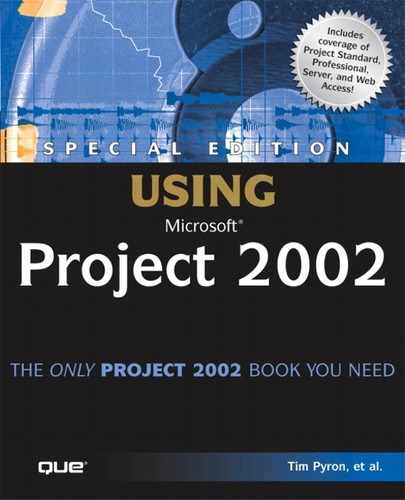Working with Enterprise Projects
Microsoft Project Professional uses enterprise project outline codes to enable the management of projects across an enterprise. When the enterprise project outline codes are assigned to projects, project data can be viewed and analyzed in a variety of ways, using the Project Center and the Resource Center.
Applying Outline Codes and Custom Fields to Projects
After the enterprise project outline codes and custom fields have been entered into the Enterprise Global, individual projects need to have the content of their enterprise project outline codes and custom fields assigned.
To apply enterprise project outline codes to enterprise projects, follow these steps:
1. |
Select Project, Project Information to display the defined enterprise project custom fields, as shown in Figure 25.22. Figure 25.22. The * at the end of an enterprise custom field indicates that it is a required field.
|
2. |
Select the value for each Custom Field from the pull-down lists in the Value column, and then click OK. |
3. |
Using a Project Schedule Template
→ For information on creating new and deleting old enterprise templates, see “Modifying the Enterprise Global Template,” p. 1118.
Opening Enterprise Templates
To open an enterprise template, select File, New, General Templates and select the Enterprise Templates tab.
→ To apply resources to an enterprise template, you can use the Substitution Wizard. For information on this wizard, see “Using the Resource Substitution Wizard,” p. 1048.
Using Project Versions
By default, Microsoft Project Professional establishes a system version called Published. Because the Published version is associated with features such as timesheet reporting (timesheets only show assignments from the Published system version), the Published version cannot be deleted from the system.
→ For information on creating new and deleting old versions of a project plan, see “Managing Project Versions,” p. 1106.
The Project Server administrator predefines the versions that are available to Microsoft Project Professional users. When versions are set up, all project information can be saved to any of the predefined versions.
Versions are useful for a number of tasks, including the following:
Performing full comparisons between versions of schedules, including added/deleted tasks and assignments, constraints, and other changes that are not saved in baselines
Performing trend analysis between versions saved at regular intervals
Performing what-if analysis on scenarios that the user might not want to make public or to affect the current or published version
Opening Project Schedules with Versions
The first time you save a project to the Project Server, you are prompted for a schedule name and version, as shown in Figure 25.23. If you save the project to a file, the project name and version are stored as part of the file name, separated by a period (for example, Denver A.Published). This provides backward compatibility (files can be saved with a filename such as Denver A.Published.mpp and opened with Microsoft Project 2000), as well as a unique naming scheme.
Figure 25.23. The project schedule here is being saved to the Published version.

Saving a project without changing the version overwrites any information that has already been saved in that version of the project. To save a different version type, click Save As and select a new type.
Versions and Resources
Resources are included in a version, but they are not associated with versions. If enterprise resource pool information (for example, availability, calendars, outline codes) changes, the information is not retroactively applied to already created versions. Resource assignments, however, do reflect the version of the project to which they belong at the time the version was created.
Versions and Cross-Project Links
In order to be active, cross-project links must occur between projects saved with the same version. For example, if you saved Project A as Version 1 and it is cross-linked to Project B, Project B must also be saved as Version 1. If it is not, the cross-project links become static or orphaned and do not update properly.



